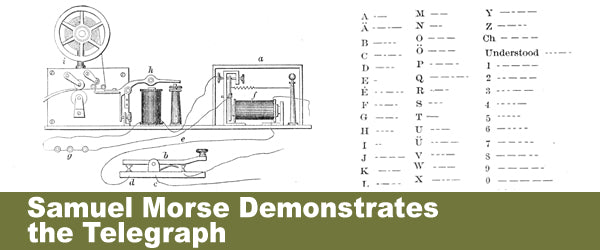
Posted by The Home School in the Woods Team on
As technology continues to advance right before our very eyes, we often forget that before swiping and scrolling, there was tapping – and by tapping, we mean morse code!
On January 6, 1838, Samuel Morse demonstrated the telegraph for the first time. In this post, we’ll discuss this revolutionary piece of technology and how it dramatically changed the course of history, as well as how we communicate with each other long distance.
Looking for a way to include the telegraph and morse code in your child’s history curriculum? Be sure to check out our Early 19th Century Time Traveler, where you can find fun, hands-on projects!
Life Before the Telegraph
Since the beginning of time, mankind has longed to find ways to simplify life through technology (e.g., the wheel, steam engine, and printing press). However, when it came to communicating over long distances, there never seemed to be a foolproof method.
Some of the earliest forms of communication included fire, smoke, drums, and even the reflection of sun rays. At times, humans or animals such as horses, dogs, and birds were given messages to deliver in the midst of perilous fights.
As time went on, people began to utilize flags, lighthouses, gunpowder, and more. Still, these strategies fell short and were never guaranteed to deliver their important messages.
It wasn’t until Benjamin Franklin explored the significance of electricity in 1759 that the world began to change the way they approached solving everyday problems. Inventors knew there was a better way to communicate over long distances using this flow of electric charge, but how exactly, they weren’t sure.
What Is the Telegraph?
According to Britannica, the telegraph is “any device or system that allows the transmission of information by coded signal over distance.” The word telegraph itself comes from the Greek words tele and graphein, which mean “distant” and “to write.”
How Does a Telegraph Work?
The electronic telegraph uses electric signals to transmit various codes over a wire or radio wave from station to station. This code, which would come to be known as “morse code,” would be received in the form of printed dots and dashes on a piece of paper under a stylus, which worked by means of electromagnetic signals from the transmitter.
Who Invented the Telegraph?
The idea of an electronic telegraph had been in the works by various inventors around the world. However, a surprising candidate was the first to put it into effect.
Samuel F.B. Morse, a professor of painting and sculpture at the University of the City of New York, became interested in the idea of building an electronic telegraph. He began drawing sketches for a potential system using dots and dashes in replacement for letters and numbers.
When and Where Was the Telegraph Invented?
Although Claude Chappe invented the first optical telegraph in France during the late 18th century, the electronic telegraph we would come to recognize today wouldn’t be created until the 19th century.
Morse began developing a prototype with his partners, Leonard Gale and Alfred Vail, in the United States. On January 6, 1837, he and his friends demonstrated how the system worked at Morse’s workplace, Speedwell Iron Works, in Morristown, New Jersey.
By 1843, Morse managed to convince the United States Congress to fund the first telegraph line running from Washington, D.C. to Baltimore. On May 24, 1844, the system was completed and ready to be used by the public. The first message sent would read, “What hath God wrought!”
The Impact of the Telegraph Invention
The era of the telegraph would last more than 100 years in the United States and see many improvements during its time. American inventor Thomas Edison advanced the telegraph by creating a quadruplex telegraph in 1874, which would permit multiple signals to transmit at the same time on a single line.
Alexander Graham Bell patented the telephone in 1876, which was intended to replace the telegraph. However, many still found the old-fashioned system to be useful over the years – especially when communicating between railroad stations or sending important military messages during World War I.
As technology began to advance in the 1960s, digital communication in the form of phone services, faxes, and emails became the preferred method. Even though Western Union delivered its last telegram in January of 2006, international morse code is still studied and used by amateur radio operators today.
Studying the Telegraph and Morse Code
Learning about the telegraph and morse code is a fun subject most children enjoy. Many are left in awe at how far technology has come in such a short amount of time! There are numerous ways you can incorporate Samuel Morse’s invention in your child’s history curriculum.
Like we mentioned before, our 19th Century Time Traveler is chock full of projects that are perfect for tactile learners. We specifically have a project dedicated to how to read morse code. We also have a timeline figure for Morse himself!
Well, there you have it. We hope you enjoyed learning about this revolutionary piece of technology. For more “this week in history” updates, be sure to follow us on Facebook and Instagram.
